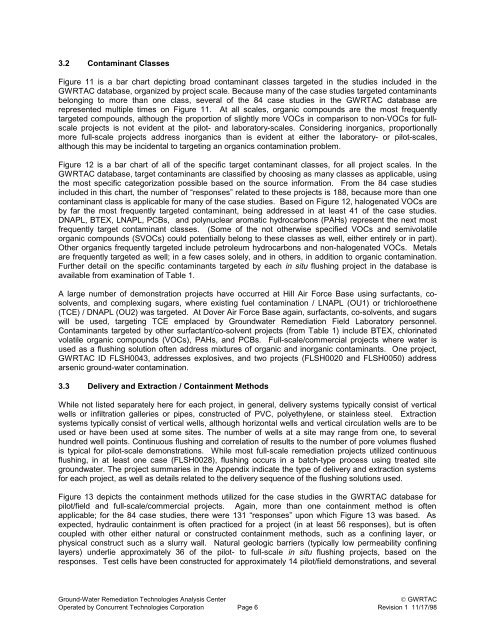Technology Status Report: In Situ Flushing - CLU-IN
Technology Status Report: In Situ Flushing - CLU-IN
Technology Status Report: In Situ Flushing - CLU-IN
Create successful ePaper yourself
Turn your PDF publications into a flip-book with our unique Google optimized e-Paper software.
3.2 Contaminant Classes<br />
Figure 11 is a bar chart depicting broad contaminant classes targeted in the studies included in the<br />
GWRTAC database, organized by project scale. Because many of the case studies targeted contaminants<br />
belonging to more than one class, several of the 84 case studies in the GWRTAC database are<br />
represented multiple times on Figure 11. At all scales, organic compounds are the most frequently<br />
targeted compounds, although the proportion of slightly more VOCs in comparison to non-VOCs for fullscale<br />
projects is not evident at the pilot- and laboratory-scales. Considering inorganics, proportionally<br />
more full-scale projects address inorganics than is evident at either the laboratory- or pilot-scales,<br />
although this may be incidental to targeting an organics contamination problem.<br />
Figure 12 is a bar chart of all of the specific target contaminant classes, for all project scales. <strong>In</strong> the<br />
GWRTAC database, target contaminants are classified by choosing as many classes as applicable, using<br />
the most specific categorization possible based on the source information. From the 84 case studies<br />
included in this chart, the number of “responses” related to these projects is 188, because more than one<br />
contaminant class is applicable for many of the case studies. Based on Figure 12, halogenated VOCs are<br />
by far the most frequently targeted contaminant, being addressed in at least 41 of the case studies.<br />
DNAPL, BTEX, LNAPL, PCBs, and polynuclear aromatic hydrocarbons (PAHs) represent the next most<br />
frequently target contaminant classes. (Some of the not otherwise specified VOCs and semivolatile<br />
organic compounds (SVOCs) could potentially belong to these classes as well, either entirely or in part).<br />
Other organics frequently targeted include petroleum hydrocarbons and non-halogenated VOCs. Metals<br />
are frequently targeted as well; in a few cases solely, and in others, in addition to organic contamination.<br />
Further detail on the specific contaminants targeted by each in situ flushing project in the database is<br />
available from examination of Table 1.<br />
A large number of demonstration projects have occurred at Hill Air Force Base using surfactants, cosolvents,<br />
and complexing sugars, where existing fuel contamination / LNAPL (OU1) or trichloroethene<br />
(TCE) / DNAPL (OU2) was targeted. At Dover Air Force Base again, surfactants, co-solvents, and sugars<br />
will be used, targeting TCE emplaced by Groundwater Remediation Field Laboratory personnel.<br />
Contaminants targeted by other surfactant/co-solvent projects (from Table 1) include BTEX, chlorinated<br />
volatile organic compounds (VOCs), PAHs, and PCBs. Full-scale/commercial projects where water is<br />
used as a flushing solution often address mixtures of organic and inorganic contaminants. One project,<br />
GWRTAC ID FLSH0043, addresses explosives, and two projects (FLSH0020 and FLSH0050) address<br />
arsenic ground-water contamination.<br />
3.3 Delivery and Extraction / Containment Methods<br />
While not listed separately here for each project, in general, delivery systems typically consist of vertical<br />
wells or infiltration galleries or pipes, constructed of PVC, polyethylene, or stainless steel. Extraction<br />
systems typically consist of vertical wells, although horizontal wells and vertical circulation wells are to be<br />
used or have been used at some sites. The number of wells at a site may range from one, to several<br />
hundred well points. Continuous flushing and correlation of results to the number of pore volumes flushed<br />
is typical for pilot-scale demonstrations. While most full-scale remediation projects utilized continuous<br />
flushing, in at least one case (FLSH0028), flushing occurs in a batch-type process using treated site<br />
groundwater. The project summaries in the Appendix indicate the type of delivery and extraction systems<br />
for each project, as well as details related to the delivery sequence of the flushing solutions used.<br />
Figure 13 depicts the containment methods utilized for the case studies in the GWRTAC database for<br />
pilot/field and full-scale/commercial projects. Again, more than one containment method is often<br />
applicable; for the 84 case studies, there were 131 “responses” upon which Figure 13 was based. As<br />
expected, hydraulic containment is often practiced for a project (in at least 56 responses), but is often<br />
coupled with other either natural or constructed containment methods, such as a confining layer, or<br />
physical construct such as a slurry wall. Natural geologic barriers (typically low permeability confining<br />
layers) underlie approximately 36 of the pilot- to full-scale in situ flushing projects, based on the<br />
responses. Test cells have been constructed for approximately 14 pilot/field demonstrations, and several<br />
Ground-Water Remediation Technologies Analysis Center © GWRTAC<br />
Operated by Concurrent Technologies Corporation Page 6 Revision 1 11/17/98
















